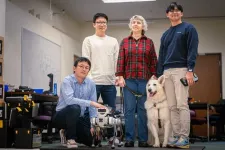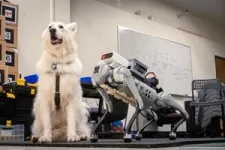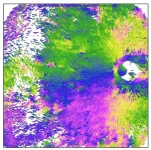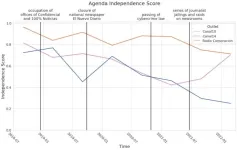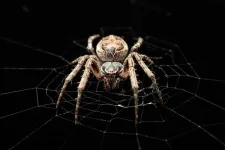(Press-News.org) May 16, 2024
To Optimize Guide-Dog Robots, First Listen to the Visually Impaired
Award-winning research led by UMass Amherst shows to be successful, Guide-dog users and trainers need to provide insight into features that make robotic helpers useful in the real world
AMHERST, Mass. — What features does a robotic guide dog need? Ask the blind, say the authors of an award-winning paper. Led by researchers at the University of Massachusetts Amherst, a study identifying how to develop robot guide dogs with insights from guide dog users and trainers won a Best Paper Award at CHI 2024: Conference on Human Factors in Computing Systems (CHI), the leading venue for human-computer interaction research.
Guide dogs enable remarkable autonomy and mobility for their handlers. However, only a fraction of people with visual impairments have one of these companions. The barriers include the scarcity of trained dogs, cost (which is $40,000 for training alone), allergies and other physical limitations that preclude caring for a dog.
Robots have the potential to step in where canines can’t and address a truly gaping need—if designers can get the features right.
“We’re not the first ones to develop guide-dog robots,” says Donghyun Kim, assistant professor in the UMass Amherst Manning College of Information and Computer Science (CICS) and one of the corresponding authors of the award-winning paper. “There are 40 years of study there, and none of these robots are actually used by end users. We tried to tackle that problem first so that, before we develop the technology, we understand how they use the animal guide dog and what technology they are waiting for.”
The research team conducted semistructured interviews and observation sessions with 23 visually impaired dog-guide handlers and five trainers. Through thematic analysis, they distilled the current limitations of canine guide dogs, the traits handlers are looking for in an effective guide and considerations to make for future robotic guide dogs.
One of the more nuanced themes that came from these interviews was the delicate balance between robot autonomy and human control. “Originally, we thought that we were developing an autonomous driving car,” says Kim. They envisioned that the user would tell the robot where they want to go and the robot would navigate autonomously to that location with the user in tow.
This is not the case.
The interviews revealed that handlers do not use their dog as a global navigation system. Instead, the handler controls the overall route while the dog is responsible for local obstacle avoidance. However, even this isn’t a hard-and-fast rule. Dogs can also learn routes by habit and may eventually navigate a person to regular destinations without directional commands from the handler.
“When the handler trusts the dog and gives more autonomy to the dog, it’s a bit delicate,” says Kim. “We cannot just make a robot that is fully passive, just following the handler, or just fully autonomous, because then [the handler] feels unsafe.”
The researchers hope this paper will serve as a guide, not only in Kim’s lab, but for other robot developers as well. “In this paper, we also give directions on how we should develop these robots to make them actually deployable in the real world,” says Hochul Hwang, first author on the paper and a doctoral candidate in Kim’s robotics lab.
For instance, he says that a two-hour battery life is an important feature for commuting, which can be an hour on its own. “About 90% of the people mentioned the battery life,” he says. “This is a critical part when designing hardware because the current quadruped robots don’t last for two hours.”
These are just a few of the findings in the paper. Others include: adding more camera orientations to help address overhead obstacles; adding audio sensors for hazards approaching from the occluded regions; understanding ‘sidewalk’ to convey the cue, “go straight,” which means follow the street (not travel in a perfectly straight line); and helping users get on the right bus (and then find a seat as well).
The researchers say this paper is a great starting point, adding that there is even more information to unpack from their 2,000 minutes of audio and 240 minutes of video data.
Winning the Best Paper Award was a distinction that put the work in the top 1% of all papers submitted to the conference.
“The most exciting aspect of winning this award is that the research community recognizes and values our direction,” says Kim. “Since we don’t believe that guide dog robots will be available to individuals with visual impairments within a year, nor that we’ll solve every problem, we hope this paper inspires a broad range of robotics and human-robot interaction researchers, helping our vision come to fruition sooner.”
Other researchers who contributed to the paper include:
Ivan Lee, associate professor in CICS and a co-corresponding author of the article along with Donghyun, an expert in adaptive technologies and human-centered design; Joydeep Biswas, associate professor at the University of Texas Austin, who brought his experience in creating artificial intelligence (AI) algorithms that allow robots to navigate through unstructured environments; Hee Tae Jung, assistant professor at Indiana University, who brought his expertise in human factors and qualitative research to participatory study with people with chronic conditions; and Nicholas Giudice, a professor at the University of Maine who is blind and provided valuable insight and interpretation of the interviews.
Ultimately, Kim understands that robotics can do the most good when scientists remember the human element. “My Ph.D. and postdoctoral research is all about how to make these robots work better,” Kim adds. “We tried to find [an application that is] practical and something meaningful for humanity.”
END
To optimize guide-dog robots, first listen to the visually impaired
Award-winning research led by UMass Amherst shows to be successful, Guide-dog users and trainers need to provide insight into features that make robotic helpers useful in the real world
2024-05-16
ELSE PRESS RELEASES FROM THIS DATE:
Imaging fibrous structure abnormalities of the white of the eye in myopathic patients
2024-05-16
Researchers provide an innovative approach to understanding ocular pathologies by visualizing the fiber structure of the sclera, the outermost eye layer
Tokyo, Japan – Eye diseases are extremely prevalent worldwide, with recent estimates suggesting that one-third of the global population suffers from some type of vision impairment. Given the high complexity of the human eye, the precise origin and nature of many eye diseases remain unclear, leaving affected people with limited diagnostic and treatment options.
Now, in a study made available online on March 7, 2024 and published in Volume 142, Number 4 of JAMA Ophthalmology on ...
Loneliness and mental health problems are interconnected
2024-05-16
“We have found a correlation between loneliness and several mental health problems,” says Associate Professor Rubén Rodríguez-Cano at the Norwegian University of Science and Technology (NTNU’s) Department of Psychology.
In a new study, researchers are looking at whether lonely people are more prone to problems such as depression and psychosis. Based on medication use, the correlation is clear.
“The risk of a lonely person also struggling with mental health problems is greater than for people who ...
Dr. Daniel Geynisman named new Editor-in-Chief for JNCCN—Journal of the National Comprehensive Cancer Network
2024-05-16
PLYMOUTH MEETING, PA [May 16, 2024] — Daniel M. Geynisman, MD, is being announced as the new Editor-in-Chief for JNCCN—Journal of the National Comprehensive Cancer Network. Dr. Geynisman has a long history of working with NCCN in a variety of roles and served as medical oncology section editor for Urologic Oncology: Seminars and Original Investigations since 2018 and authored more than 130 peer-reviewed publications. He is an Associate Professor in the Department of Hematology/Medical Oncology and Chief of the Division of Genitourinary Medical Oncology at Fox Chase Cancer Center.
“We are thrilled to welcome Dr. Geynisman into this ...
A new and better way to detect media censorship
2024-05-16
Worldwide news media are facing increasing pressure from autocrats to report favourably about their leaders and party politics. Political scientists launch a new computational method that can detect such media censorship by states while it is happening. This method provides valuable insights for communicating regime-driven media capture to the public. It is now described in detail in the scientific journal ‘Democratization’.
One of the first steps of would-be autocrats is to control the ...
Listening to muscles
2024-05-16
Spinal muscular atrophy or “SMA” for short is a terrible disease in which a genetic mutation causes certain nerves responsible for sending signals to muscles to degenerate. This leads to muscles wasting away, and many patients have died a painful death due to this rare condition. Genetic treatments have only been available for a few years. Now, a team led by Emmanuel Nedoschill, Ferdinand Knieling and Adrian Regensburger from the “Translational Pediatrics” working group at the Department of Pediatrics and Adolescent Medicine at Uniklinikum Erlangen have devised ...
Spider silk sound system #ASA186
2024-05-16
OTTAWA, Ontario, May 16, 2024 – The best microphone in the world might have an unexpected source: spider silk. Spiders weave webs to trap their insect snacks, but the sticky strands also help spiders hear. Unlike human eardrums and conventional microphones that detect sound pressure waves, spider silk responds to changes in the velocities of air particles as they are thrust about by a sound field. This sound velocity detection method remains largely underexplored compared to pressure sensing, but it holds great potential for high-sensitivity, long-distance sound detection.
Researchers ...
Equitable opportunity for transplants: Experts provide disparity-sensitive measures for transplant centers
2024-05-16
INDIANAPOLIS – An Expert Insight, published in the journal Transplantation, highlights health equity, disparity and inequality in organ transplantation along the continuum of care and across organ types. The authors provide a guide to transplant centers for the use of disparity-sensitive measures to monitor and address health disparities in transplantation and to redress long-standing inequities and inequalities in this vital arena.
“Our goal is to ensure that all patients who need a transplant have ...
Gene therapy relieves back pain, repairs damaged disc in mice
2024-05-16
COLUMBUS, Ohio – Disc-related back pain may one day meet its therapeutic match: gene therapy delivered by naturally derived nanocarriers that, a new study shows, repairs damaged discs in the spine and lowers pain symptoms in mice.
Scientists engineered nanocarriers using mouse connective-tissue cells called fibroblasts as a model of skin cells and loaded them with genetic material for a protein key to tissue development. The team injected a solution containing the carriers into damaged discs in mice at the same time the back injury ...
To sound like a hockey player, speak like a Canadian #ASA186
2024-05-16
OTTAWA, Ontario, May 16, 2024 – As a hockey player, Andrew Bray was familiar with the slang thrown around the “barn” (hockey arena). As a linguist, he wanted to understand how sport-specific jargon evolved and permeated across teams, regions, and countries. In pursuit of the sociolinguistic “biscuit” (puck), he faced an unexpected question.
“It was while conducting this initial study that I was asked a question that has since shaped the direction of my subsequent research,” said Bray. “‘Are you trying to figure out why the Americans sound like fake Canadians?’”
Canadian ...
Why do we overindulge?
2024-05-16
If you tend to do other things or get distracted while eating dinner, you may be running the risk of over-consuming everyday pleasures later, possibly because the distraction caused you to enjoy yourself less, according to research published by the American Psychological Association.
The study looked at how distraction affects “hedonic consumption,” or buying and using products and experiences because they make us feel good and not necessarily because we need them.
“On any given day, a person may take great pleasure from one or more of these activities, yet people often consume more hedonic ...
LAST 30 PRESS RELEASES:
Ticking time bomb: Some farmers report as many as 70 tick encounters over a 6-month period
Turning garden and crop waste into plastics
Scientists discover ‘platypus galaxies’ in the early universe
Seeing thyroid cancer in a new light: when AI meets label-free imaging in the operating room
Neutrophil-to-lymphocyte ratio may aid risk stratification in depressive disorder
2026 Seismological Society of America Annual Meeting
AI-powered ECG analysis offers promising path for early detection of chronic obstructive pulmonary disease, says Mount Sinai researchers
GIMM uncovers flaws in lab-grown heart cells and paves the way for improved treatments
Cracking the evolutionary code of sleep
Medications could help the aging brain cope with surgery, memory impairment
Back pain linked to worse sleep years later in men over 65, according to study
CDC urges ‘shared decision-making’ on some childhood vaccines; many unclear about what that means
New research finds that an ‘equal treatment’ approach to economic opportunity advertising can backfire
Researchers create shape-shifting, self-navigating microparticles
Science army mobilizes to map US soil microbiome
Researchers develop new tools to turn grain crops into biosensors
Do supervised consumption sites bring increased crime? Study suggests that’s a myth
New mass spec innovation could transform research
Maternal nativity, race, and ethnicity and infant mortality in the US
Migration-related trauma among asylum seekers exposed to the migrant protection protocols
Jupiter’s moon Europa has a seafloor that may be quiet and lifeless
SwRI upgrades nuclear magnetic resonance laboratory for pharmaceutical R&D
House sparrows in northern Norway can help us save other endangered animals
Crohn's & Colitis Foundation survey reveals more than 1/3 of young adults with IBD face step therapy insurance barriers
Tethered UAV autonomous knotting on environmental structures for transport
Decentralized social media platforms unlock authentic consumer feedback
American Pediatric Society announces Vanderbilt University School of Medicine as host institution for APS Howland Visiting Professor Program
Scientists discover first method to safely back up quantum information
A role for orange pigments in birds and human redheads
Pathways to net-zero greenhouse gas emissions for Southeast Asia
[Press-News.org] To optimize guide-dog robots, first listen to the visually impairedAward-winning research led by UMass Amherst shows to be successful, Guide-dog users and trainers need to provide insight into features that make robotic helpers useful in the real world
